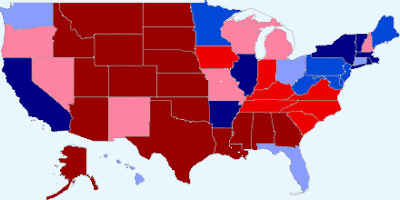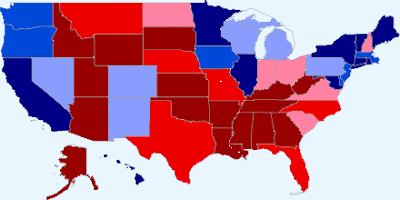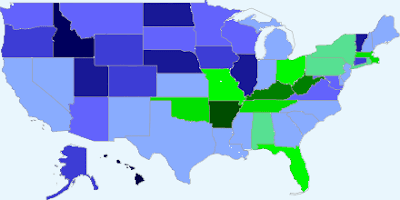Other than North Dakota, though, there were several changes to the McCain-Obama map.
Colorado: The Centennial state continues to look like a fall battleground state by flipping back toward Obama this week.
Indiana: The Hoosier state shifted from McCain lean to Toss Up McCain.
Michigan: Michigan is shaping up to be a valuable piece of the next president's path to the White House. The Wolverine state had been favoring Obama for the last several weeks, but shifted back toward McCain over the course of the last week. Along with Indiana above, Michigan forms a band of competitive states in a McCain-Obama match up. This grouping stretches from Wisconsin through Michigan and down through and across Indiana, Ohio and Pennsylvania.
Minnesota: On the western border with Wisconsin, though, is a state that is going in the other direction. Minnesota is getting less competitive and is now in the Strong Obama category. The North Star state could certainly come back into play if McCain opts for the state's Republican governor, Tim Pawlenty, as his running mate. And he may have to if the state continues to trend toward Obama while proving a potentially valuable 10 electoral votes.
South Dakota: Both Dakotas have given Obama some positive poll numbers, but both have been solidly Republican at the presidential level for a while now and have certainly moved back in that direction with the most recent polls. South Dakota had been a toss up state for McCain, but has jumped into the solid McCain area now.
While there were changes in the map, there were only a handful of consequential shifts. Michigan's move toward McCain shifted those 17 electoral votes into his column, and in the process, turned a two electoral vote McCain victory into a more solid (Bush/Kerry-esque) 281-257 edge for McCain (with the North Dakota and Colorado shifts).
 And what about the Clinton map? There was plenty of movement, but the movement was toward the extremes. Blue states became bluer and red states became redder. Pennsylvania got darker for Clinton and Texas fell in line behind McCain as it has reliably for the GOP during recent cycles. The McCain-Clinton map already looked similar to the maps from both 2000 and 2004 and could still end up that way. And those battleground states are largely the same, though, some (most notably Florida, Michigan and Ohio) have switched sides. Clinton would narrowly win the electoral college if these weighted averages reflected how each state will vote just over five months from now.
And what about the Clinton map? There was plenty of movement, but the movement was toward the extremes. Blue states became bluer and red states became redder. Pennsylvania got darker for Clinton and Texas fell in line behind McCain as it has reliably for the GOP during recent cycles. The McCain-Clinton map already looked similar to the maps from both 2000 and 2004 and could still end up that way. And those battleground states are largely the same, though, some (most notably Florida, Michigan and Ohio) have switched sides. Clinton would narrowly win the electoral college if these weighted averages reflected how each state will vote just over five months from now. So Clinton does better against McCain and the Democrats have picked the wrong nominee again. Well, yes and no. Yes, the New York senator has a slight advantage over McCain in the electoral college, but it doesn't amount to too terribly much in relation to Obama. As we have seen, just one state (Michigan, for example) can turn the tide. And when we examine the McCain margin (the difference between each candidates margins against McCain in all 50 states), what we see is that neither candidate makes all that much difference. The darker a state is, the greater a difference a candidate makes (green for Clinton and blue for Obama). What we see below is a very light map. There just aren't that many states where one Democrat fares much better against McCain than the other (...that they aren't going to win or lose anyway). For Obama, Colorado, Connecticut, Iowa and Oregon are states he is in a position to win where Clinton lags. Arkansas, Kentucky and West Virginia are those states for Clinton. All three are firmly in the GOP column in an Obama-McCain pairing, but are much more competitive when Clinton is the nominee.
So Clinton does better against McCain and the Democrats have picked the wrong nominee again. Well, yes and no. Yes, the New York senator has a slight advantage over McCain in the electoral college, but it doesn't amount to too terribly much in relation to Obama. As we have seen, just one state (Michigan, for example) can turn the tide. And when we examine the McCain margin (the difference between each candidates margins against McCain in all 50 states), what we see is that neither candidate makes all that much difference. The darker a state is, the greater a difference a candidate makes (green for Clinton and blue for Obama). What we see below is a very light map. There just aren't that many states where one Democrat fares much better against McCain than the other (...that they aren't going to win or lose anyway). For Obama, Colorado, Connecticut, Iowa and Oregon are states he is in a position to win where Clinton lags. Arkansas, Kentucky and West Virginia are those states for Clinton. All three are firmly in the GOP column in an Obama-McCain pairing, but are much more competitive when Clinton is the nominee. While both candidates take different routes to their electoral vote totals, they are both close enough to each other relative to McCain in most of the swing states. Close enough that one state flipping into or out of the Republican total could give either Democratic candidate more than 270 electoral votes. As of now, Michigan, Nevada and Ohio are the most likely to shift to the other side of the aisle on the McCain-Obama map, whereas Missouri is the most likely to shift in the coming weeks (or week if this nomination race comes to a close after Montana and South Dakota) if Clinton were considered the nominee.
While both candidates take different routes to their electoral vote totals, they are both close enough to each other relative to McCain in most of the swing states. Close enough that one state flipping into or out of the Republican total could give either Democratic candidate more than 270 electoral votes. As of now, Michigan, Nevada and Ohio are the most likely to shift to the other side of the aisle on the McCain-Obama map, whereas Missouri is the most likely to shift in the coming weeks (or week if this nomination race comes to a close after Montana and South Dakota) if Clinton were considered the nominee.*I should also note that any and all feedback on the new look maps is welcomed and appreciated. Thanks again to all those who chimed in over the weekend.
***Please see the side bar for links to past electoral college comparisons.***
Recent Posts:
Test Run: The McCain-Obama Map (5/28/08)
Kansas Final Tally: 73.9% of the Vote, 71.8% of the Delegates
Reader Feedback Wanted: New Electoral College Maps?








